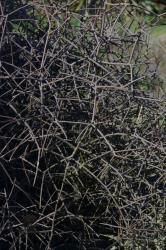- Taxon
- Gallery
Bushy shrubs or small trees up to 5 m tall (Fig . 1). Exposed plants with rounded, springy, grey-brown crowns 2—3 m diam., frequently smothered with lichens and mosses. Shaded plants with smaller, green, segmented crowns intermixed with those of other shrubs. Stems erect or leaning, knobbly, tortuous, 3—15 cm diam., with regular coppice and epicormic shoots. Outer bark greenish, grey, or light brown, smooth or lenticellate, persistent; inner bark yellow-orange. Branchlets slender, curved, terete, finely pubescent at first, later finely lenticellate; strongly interlaced on exposed plants and commonly leafless, tapering to spinous tips; less interlaced on shaded plants and tapering to acute tips. Cotyledons 2, rarely 3, 5—8 × 3—5 mm, obovate, retuse, areolate, brown. Seedling and juvenile leaves alternate, 5—65 × 3—8 mm, shortly petiolate, deflexed, brown; at first small, ovate-lanceolate, incised, areolate; later linear to linearlanceolate with distinct irregular teeth; ± summergreen (Fig . 2, 3). Adult leaves usually confined to epicormic or shaded growths, or the centre of exposed crowns; alternate, 10—30 × 1—5 mm, solitary or fascicled, shortly petiolate, linear or linear-oblong, entire or irregularly lobed, often curved and sometimes sinuous, submembranous, green or dark green. Plants unisexual; flowers nectariferous, scented, perianth and androecium 5-merous, gynoecium 2-merous; solitary or more rarely paired or in threes, axillary, pendulous. Peduncles slender, 0.5–2 mm long, deflexed, green, with 2 minute, opposite, ovate, erose bracteoles near the base. Male flowers 2.5–3 mm diam.; sepals broadly ovate to deltoid, 1 .5– 2 mm long, green suffused with red, with paler or brownish, membranous, erose margins; petals somewhat fleshy, oblong, 2–3 mm long, white to pale yellow, with reflexed, thickened, erose tips; anthers sessile, oblong, 1 .0 mm long, 4-loculed, creamy yellow, with an extended, toothed or fimbriate, membranous connective. Erect nectary appendage attached basally to the dorsal surface of each stamen, 0.8–1 mm long, sub-pandurate, green. Anthers connate to form an urceolate tube surrounding a rudimentary gynoecium. Female flowers smaller, 1.8– 2.0 mm diam., on shorter peduncles, often almost sessile and less pendulous; bracteoles, sepals, and petals as in male flowers but smaller; stamens and nectary appendage aborted; ovary 1.0 mm long, ovoid, green, carpels 2; style slender, reaching corolla rim, 2-fid, green; stigma lobes flared. Fruit a subglobose berry 3.5–5.0 mm diam., oftendepressed or laterally compressed, white with dark purple to black flecks and spots above; mesocarp purple-stained beneath flecks, otherwise white. Pyrenes usually 2, 3-3.5 mm long, piano-convex, greyish purple; smaller berries with 1 ellipsoid pyrene with a median longitudinal furrow. Seed endospermous. FLOWERING: August to November. Flowering appears to be annual but periodic in intensity, and the flowers are entomophilous. In one population studied (Springs Junction), the ratio of male to female plants was 1:1. Outlying or isolated female plants are rarely pollinated. Floral induction occurs in the summer preceding flowering, and new buds are visible in May. FRUITING : February to May. In populations with plants of both sexes in close proximity, female plants set abundant fruit. The fruit is probably dispersed by lizards (cf . Whitaker 1987) and water, although much is shed beneath female plants. Seeds germinate in the second spring following flowering.
[Reproduced from Molloy & Druce (1994, New Zealand J. Bot. 32: 113–118) with permission from The Royal Society of New Zealand.]




